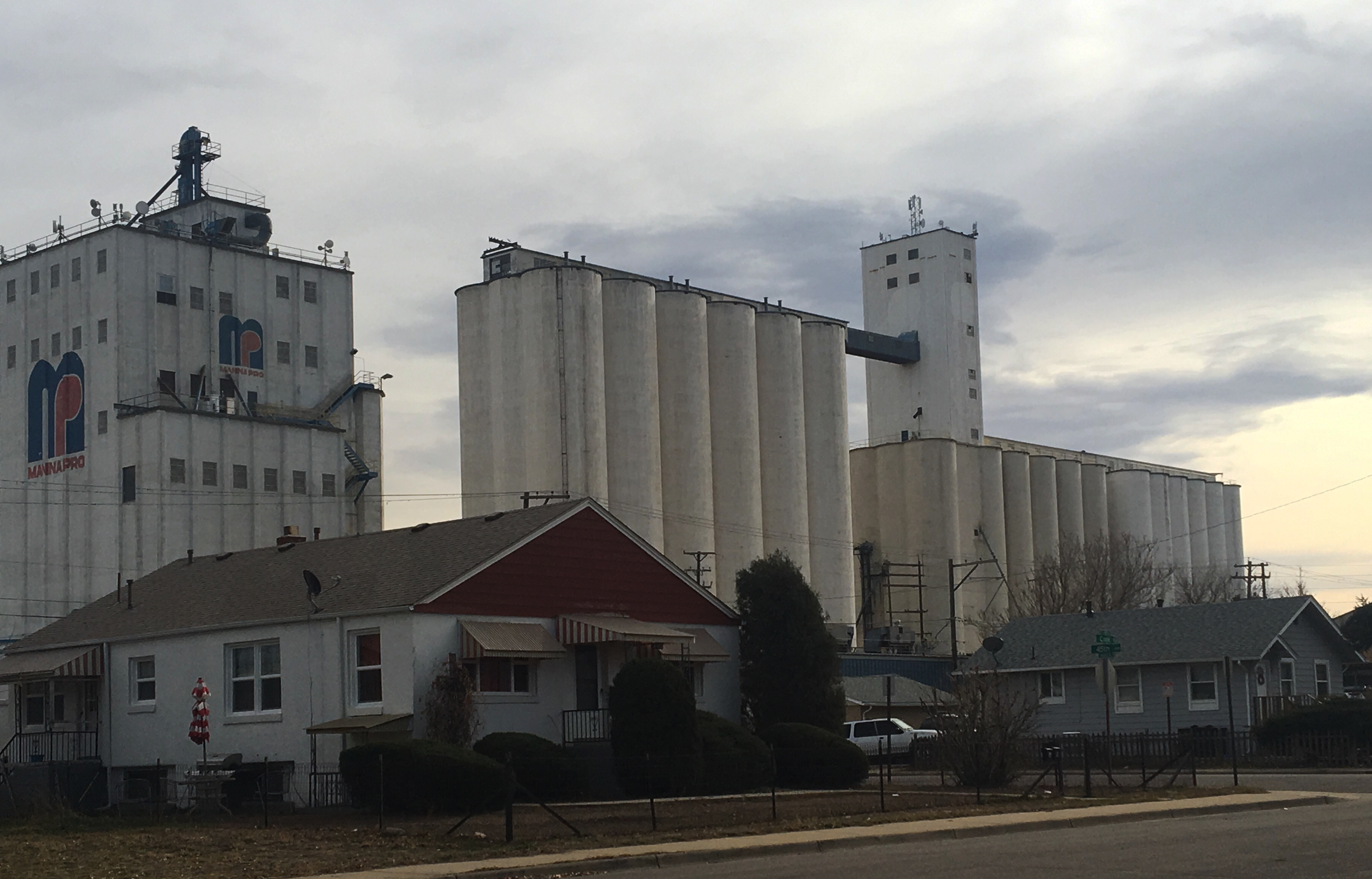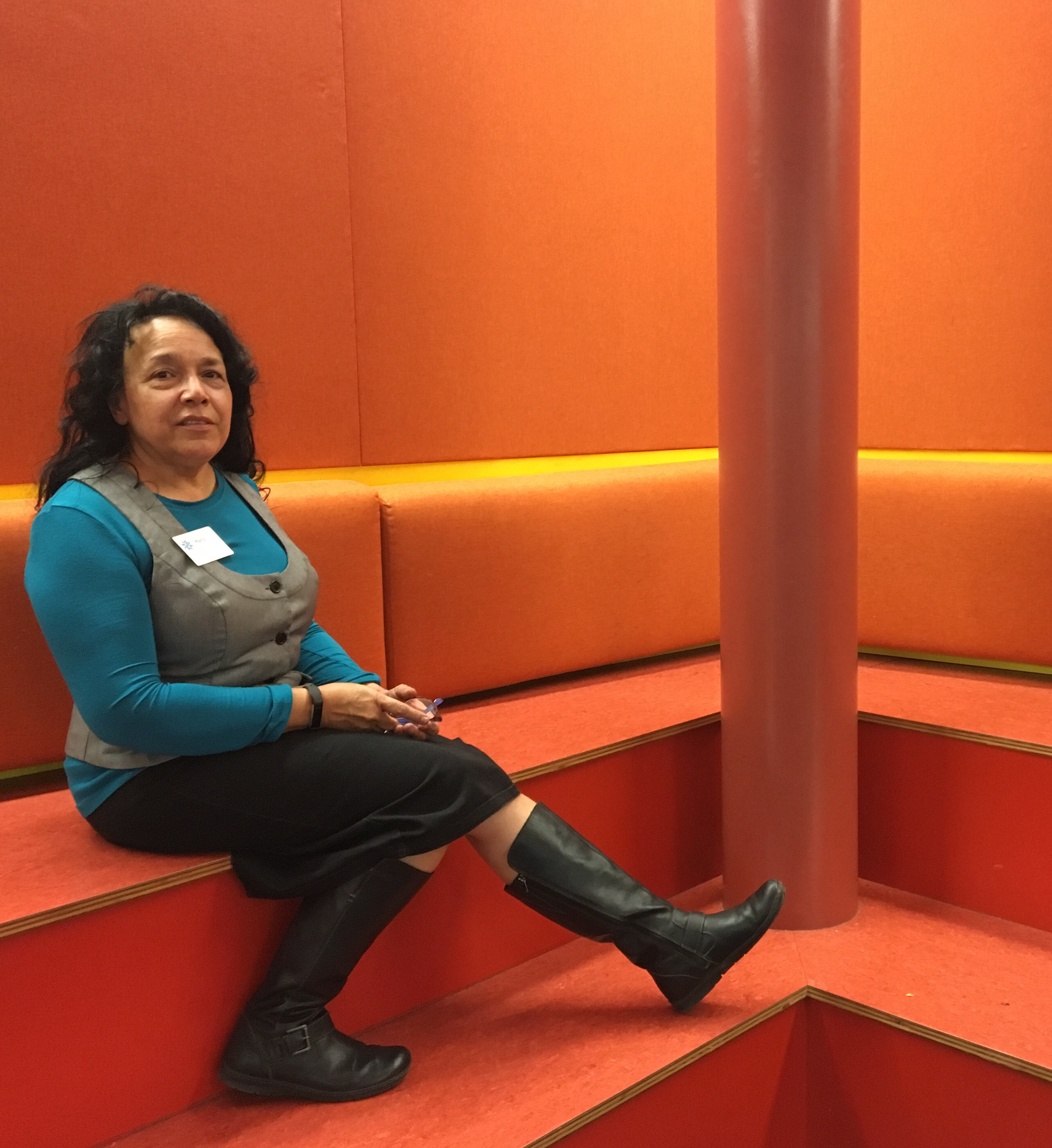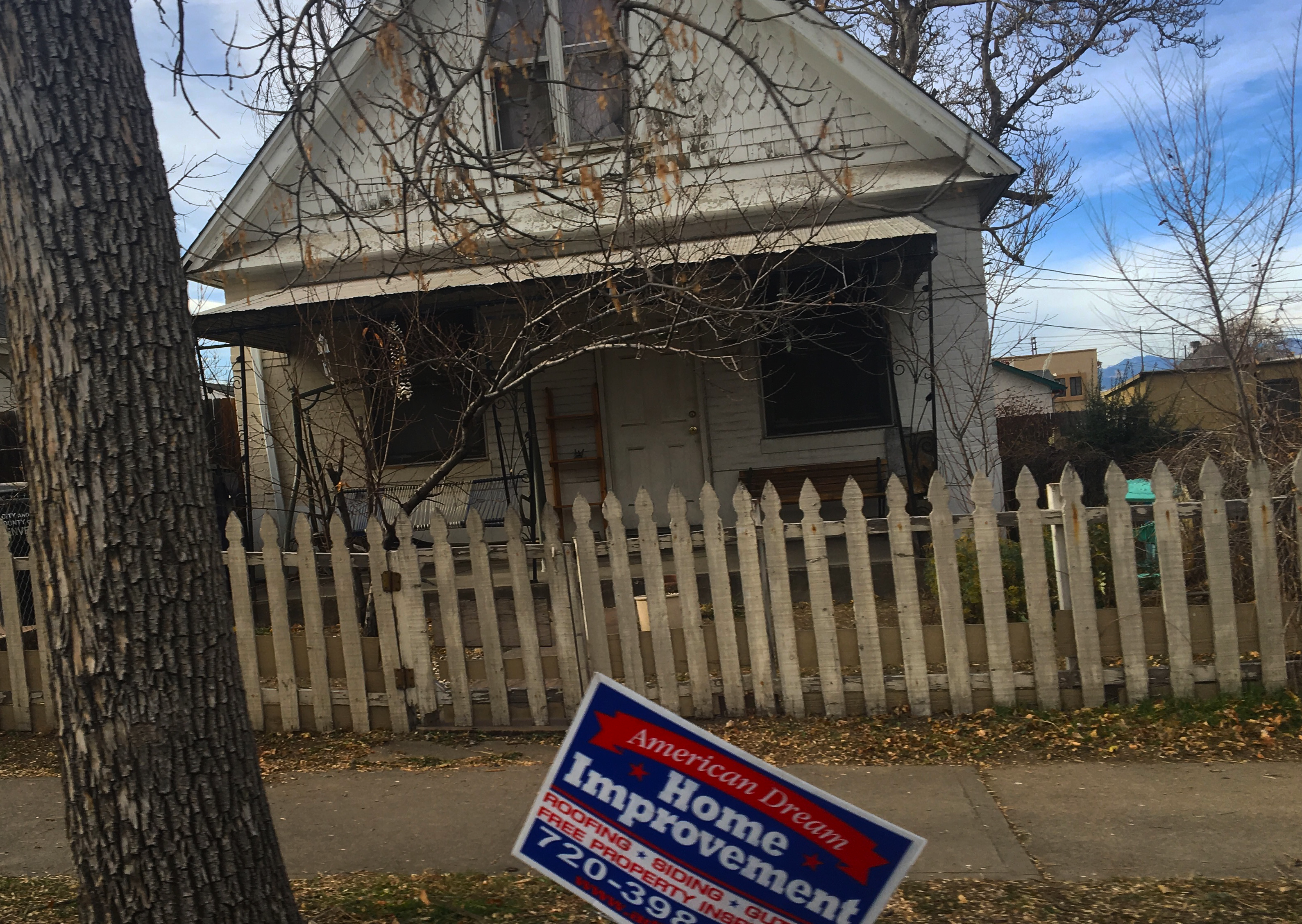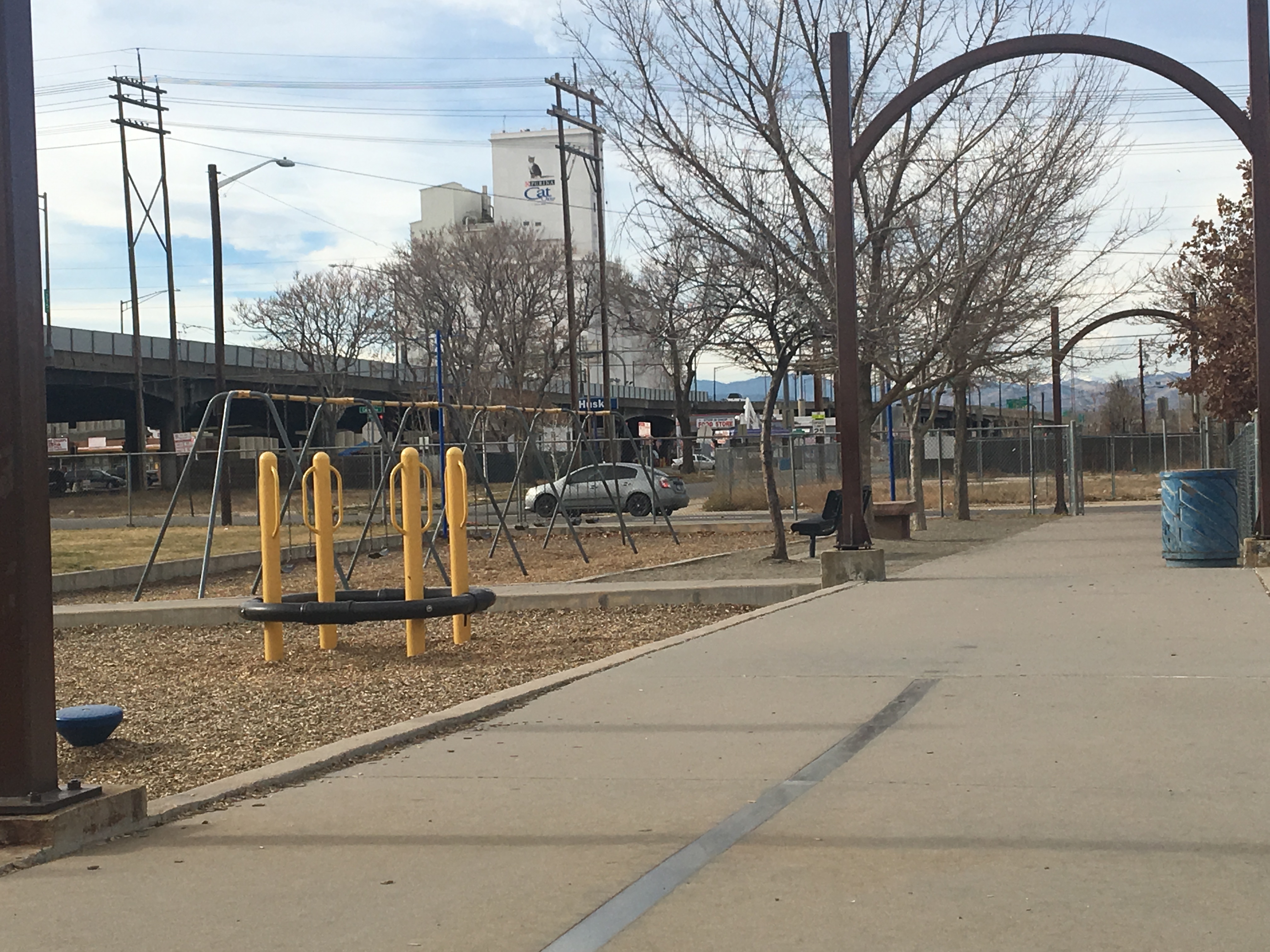By Cheyenne DeChristopher

Horn blasts and the constant whiz of trucks speeding past one another drown out the carefree laughter of children at play below the concrete viaducts of the interstate. In this Denver neighborhood, smokestack plumes, dead twisted trees and the great looming shadows of factories have taken the place of open spaces, parks and community murals. It is no coincidence that Globeville, Elyria and Swansea, low income communities of color, are left alone to suffer through generations of violence as caused by great environmental injustice.

Mary Hernandez has lived in Globeville, Elyria and Swansea respectively for over 20 years. As an artist, teacher, activist and active community member, Hernandez spends her time volunteering at various branches of the Denver Public Library for their Plaza Program. She teaches art to children whose parents are immigrants, refugees and asylum recipients working on second language skills, citizenship and business networking.
Growing up in Swansea, Mary, her sister and especially her father, Joe Montoya, were very involved in community organizing. Montoya would regularly meet with area leaders to work on keeping graffiti and other crimes out of his neighborhood. Hernandez and her sister would regularly write and send letters to officials and news outlets.
They would often speak to and meet local politicians to discuss neighborhoods issues and ideas. The family was deeply invested in the wellbeing of their tight-knit community and were devastated when homes they had lived in for generations were torn apart to make way for the new I-70 highway.
“I had a pretty enjoyable childhood living there at 4642 York Street. When I-70 was constructed the first time, a couple houses down from me, my beautiful block was torn down and turned into a half block,” wrote Hernandez.
For Hernandez, this became one of many consequences of living in the most polluted zip code in the United States, which remains an ongoing struggle.
In the recently created Environmental Data Index from ATTOM Data Solutions, over a thousand zip codes were judged by four factors and ranked from most to least toxic. The factors were overall air quality, the number of Superfund sites, brownfield sites and active polluters present within each area. Colorado’s 80216 zip code, which encompasses Globeville, Elyria and Swansea, ranked highest in three of four categories, excluding overall air quality.
Daren Blomquist, Senior Vice President of Communications at ATTOM Data Solutions, was surprised himself that the level of toxic and hazardous environmental factors in the 80216 area code did not deter property or housing growth in the area. Instead, Globeville, Elyria and Swansea have become the most affordable neighborhoods to live in Denver. Globeville, Elyria and Swansea have always been home to immigrants and their families. Historically, Eastern European immigrants settled in this area due to the promise of nearby work at the various gold and silver smelting plants and the cheap housing options for their families.
The South Platte River’s fertile and nutrient-rich soil was once a source of pride for the North Denver neighborhoods. However, when the American Smelting and Refining Company’s (ASARCO) plant began operating in the 1880s, the soil started to become polluted. The ASARCO Plant originally smelted gold and silver and later refined arsenic and cadmium in the mid-1920s. The Environmental Protection Agency's (EPA) website now lists it as a Superfund site because it has been slowly poisoning the surrounding communities’ air and soil for centuries.
Globeville, Elyria and Swansea are also food deserts, which means there is no local grocery and produce store for residents of the three communities. A Whole Foods recently opened nearby, but it’s a wholly unaffordable option for the residents. The ability to be self-sustaining and grow their own food is one of their only options. But with the toxic carcinogens hidden within the soil, community members are left with few choices for food.
The current residents of these neighborhoods are similar to their historical counterparts. People continue to settle this area because of the promise of affordable housing and the prospect of working in a nearby factory or refinery. Residents now are mainly Latinx, Spanish-speaking and many don’t have higher than a high school education. Both currently and historically, these neighborhoods and the environmental issues that affect them are mostly forgotten by Denver and the state of Colorado.
“The government never warned us about the dangers. They didn’t tell us about not growing a garden and what would happen if you grew a garden. We were all moving soil. We planted gardens. We moved the soil many times for landscaping. We ran around constantly without shoes during our childhood,” said Hernandez.

Hernandez can recall attending community meetings where soil toxicity was discussed, along with a map that pointed out the most polluted locations in her neighborhood. Her house held the worst contaminants in her area.
Not knowing how toxic her soil was, she and her father dug out her childhood home to build a basement. Before this point, her family was relatively healthy with little to no pre-existing conditions or history of illness. However, Hernandez, her family, their children and grandchildren are now suffering after exposure to the soil. Asthma, heart disease, hypothyroidism, multiple allergies, types of cancer and birth defects are now present in her family, as well as uterus-related illness including frequent miscarriages and uterine cancer, which lead to the removal of the organ entirely. Her daughter even gave birth to two children who both were born blind because of the rare condition septo-optic dysplasia, which has never previously presented in her family history.
Across the state, poor and working poor communities of color are disproportionately impacted by disease, injury, disabilities and even death, according to the Colorado Department of Public Health and Environment (CDPHE). It’s no coincidence that a recent Health Impact Assessment (HIA) also found that life expectancy greatly varied between 80216 area residents and those of nearby neighborhoods. For Elyria and Swansea, the average life expectancy is 78, while for Globeville it’s 73. Stapleton, just 15 minutes away, has a life expectancy of 84.
The neighborhoods heavy history of smelting and arsenic and cadmium refinement can still be found in the soil. The 80216 area code also houses two Superfund sites, a natural resource damage site, the combination I-70/I-25 highway and a planned highway expansion.
With the City of Denver’s plans to continue the I-70 expansion and create a sunken highway, preparations for workers to dig out the necessary 40 feet will only continue to move around the soil and unearth decades of pollution.
One of the area’s major polluters, Suncor Energy Refinery, had two major malfunctions within the last year that caused residents within a two-mile radius to have to shelter in place. The refinery continues to spew out a plethora of toxic gases, including hydrogen cyanide – which was once used to kill death row inmates in state penitentiaries – into the Globeville, Elyria and Swansea neighborhoods, and is even looking to expand its operations.
Lloyd Burton, former Professor of 30 years at CU Denver and the Environmental Justice Specialist Transportation Team Member for the Colorado Sierra Club, created the Denver Area Environmental Justice Initiative, which focuses specifically on the 80216 area code and the gross environmental injustice against that community.
“CDOT, they are trying to replicate the 1960s. We don’t think you should be Los Angeles-izing Denver, you need to be San Francisco-izing Denver,” said Burton in reference to the planned I-70 expansion.
Intercity highways that intersected low-income, minority communities were once commonplace in cities across the U.S. like Los Angeles. However, many major cities have now begun taking steps to reverse and remove these major polluters, aiming to instead create open spaces, parkways with trees and other environmentally responsible places within historically underserved and neglected communities. However, Denver has failed to take these actions.
The explanation for the intentional targeting of Globeville, Elyria and Swansea comes from the racial and class makeup of the area.
“Highway routes always follow the geographical path of least political resistance,” said Burton.
As a poor, mainly Spanish-speaking community of color that’s already facing issues of job insecurity and immigration, these north Denver neighborhoods often don’t have the resources to stand up for themselves and advocate for their community. They are the most vulnerable to big institutional changes handed down to them from the Colorado Department of Transportation (CDOT) and the city government of Denver.
“It hurts. I see what’s going to happen to the people in the next generations and next. They’re going to suffer,” said Hernandez.
Having witnessed the original construction of I-70, Hernandez is watching history repeat itself as more Latinx families are displaced simply due to the land their homes are on. She is often hurt watching children in her library program disappear, their families falling victim to illegal means of eviction including immigration threats and continued exorbitant rent increases.

The community continues to change, making way for bigger highways, more wealthy businesses and new white affluent residents, all at the expense of the generations of families of color who still call these neighborhoods home.
In an attempt to reclaim their home and their lands, community members like Hernandez are taking steps to fight back.
One such community member is Maria Diego, Organizer at Protegete of Conservation Colorado. Diego helps empower groups of women and community members to make institutional changes to their neighborhood. She does this by establishing a small community of residents and teaching them sessions on subjects such as how laws work, how to self-advocate and more.
Diego, who currently works in Montbello, plans to focus on Globeville, Elyria and Swansea as her next community.
“When you’re a mom, you want the best for your child. If you don’t fight for it, no one will. No one will tell your representatives your needs but yourself and families are there to help,” said Diego.
Mirroring that sentiment, the community of Globeville, Elyria and Swansea have been and will continue to push against the generations of environmental injustice. Through self advocacy, education, community and sharing how their lives and families have been affected, residents like Hernandez continue to resist plans for more environmental trauma.
“I know there is no stopping this expansion of I-70, and I am just the voice of one crying in the wilderness. I just want to say good luck to these people and the moving of a lot of poisoned soil once again. Most people in the area will truly be affected. This is a farce and destruction of another population of people that may have been healthy. I just hope and pray there will be a place soon for these displaced people. I feel for you Swansea, I feel for you Elyria, I feel for you, Globeville. I feel for you, my family, for now and generations. Such an injustice has been made and continues to the next generation and the next,” says Hernandez.
We’re stronger together.
If you feel outraged and inspired to take action in support of community members like Hernandez and the residents of Globeville, Elyria and Swansea, we encourage you to connect and get involved with local organizations such as the Sierra Club Colorado Chapter, Protegete, and the Colorado Latino Forum. Contact your local representatives and advocate against the proposed highway expansion for the community living in the overlooked Globeville, Elyria and Swansea.
You can also add your voice to fight pollution from the Suncor refinery in North Denver by signing here or learn more about our environmental justice work across the state here.